| ID |
Date |
Author |
Subject |
|
35
|
Sat Jul 9 21:26:25 2016 |
J.L. Tain | EDACQ | Electronics and DACQ for July 2016 assembly: hardware and connections |
| Attachment 1: EDACQ-July2016.pdf
|



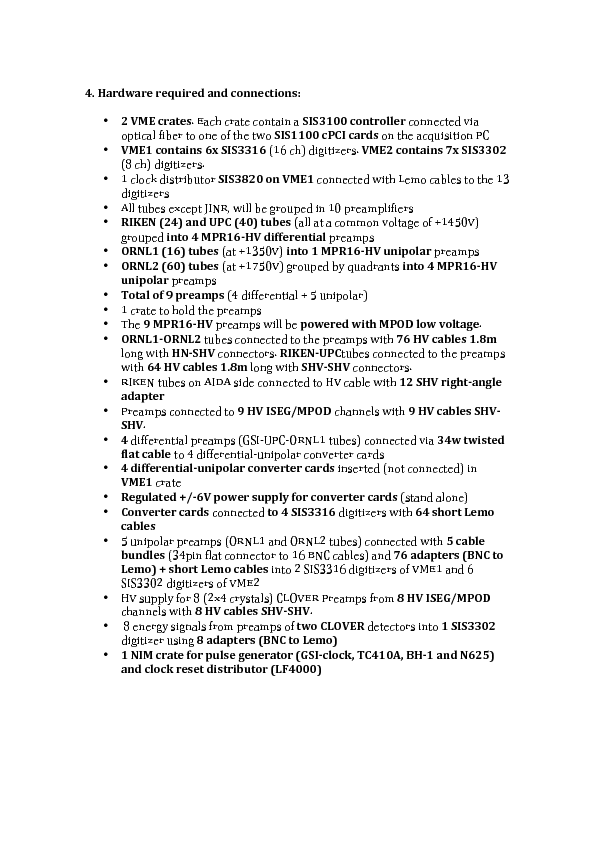



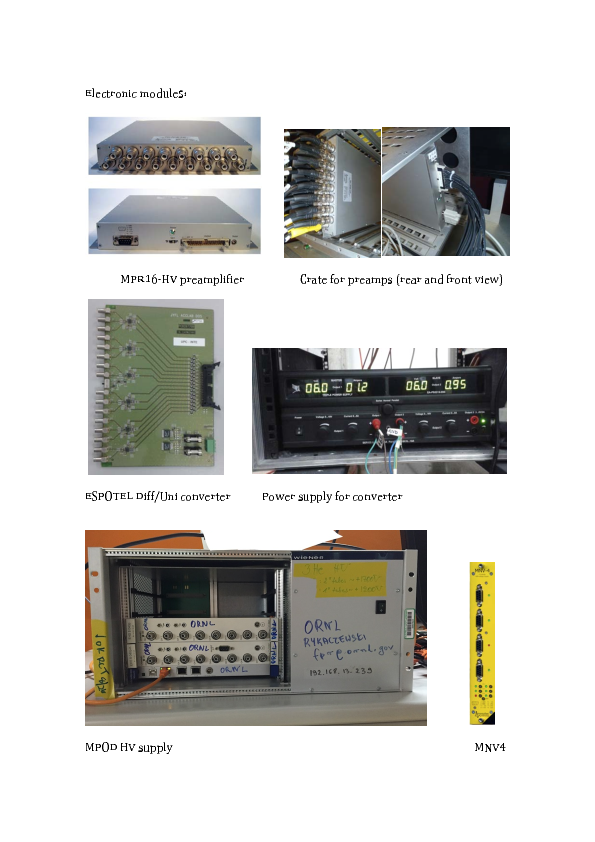
|
|
40
|
Mon Jul 18 19:01:36 2016 |
J.L. Tain | 3He tubes | Adjustment of HV and PA gain
We adjust the HV for each tube type and the gain of the preamplifier (PA) in order
to have a similar signal amplitude for the 764keV peak in all of them.
Because of the very different gain between tubes we are not able to combine in the same
PA tubes from RIKEN and UPC, thus we have to go for 10 PA instead of 9:
Settings: Preamp (type), Tube type, HV, Gain, height or 764keV pulse, pulse polarity
PA1 (D), RIKEN, 1450V, LowGain, ~400mV, POS
PA2 (D), RIKEN, 1450V, LowGain, ~400mV, POS
PA3 (D), UPC, 1550V, HighGain, ~400mV, POS
PA4 (D), UPC, 1550V, HighGain, ~400mV, POS
PA5 (U), UPC, 1550V, HighGain, ~600mV, NEG
PA6 (U), ORNL1, 1200V, LowGain, ~400mV, NEG
PA7 (U), ORNL2, 1750V, LowGain, ~400mV, NEG
PA8 (U), ORNL2, 1750V, LowGain, ~400mV, NEG
PA9 (U), ORNL2, 1750V, LowGain, ~400mV, NEG
PA10 (U), ORNL2, 1750V, LowGain, ~400mV, NEG
We need to use two different pulse generators to adjust differently the pulse height
of UPC tubes |
|
47
|
Wed Jul 20 11:16:18 2016 |
J.L. Tain | Electronics | Pulser settings
We use two pulsers, Pulser1 for RIKEN, ORNL1 and ORNL2 tubes (7 PA)
and Pulser2 for UPC tubes due to the different gains (3 PA)
10HzClock->G&DG->Pulser->LinearFI/FO
Pulser1: BNC BH-1: trise=1us, tfall=1ms, amp=670mV(scope), NEG
Pulser2: BNC PB-5: tfall=1ms, amp=0.180mV(setting), 90mV(scope), NEG
Later on we found out that Pulser1 is compatible also for
the CLOVER detectors (8PA). This will require an additional LinearFI/FO |
|
59
|
Fri Jul 22 12:50:29 2016 |
J.L. Tain | END | 20/JUL/2016 20:00
End of the test measurements |
|
19
|
Mon May 4 15:03:47 2015 |
J.Agramunt J.L.Tain K.Gabor | New detector placed under the beam line | New detector placed under the beam line, below MUSIC chamber
This detector replace the USA tubes in the DACQ because we need the preamp to plug it.
|
| Attachment 1: photo_2-2.JPG
|

|
| Attachment 2: photo_1-2.JPG
|
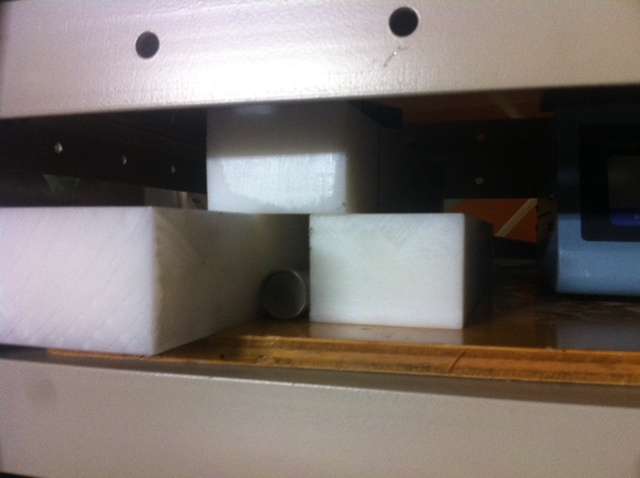
|
| Attachment 3: photo_3-2.JPG
|

|
|
15
|
Mon May 4 02:26:14 2015 |
J.Agramunt J.L.Tain K.Gabor | F11 trigger plugged in Mod2 Ch16 of Briken daq | |
|
16
|
Mon May 4 02:36:16 2015 |
J.Agramunt J.L.Tain K.Gabor | Maki trigger plugged in Mod2 Ch9 | |
|
18
|
Mon May 4 04:14:18 2015 |
J.Agramunt J.L.Tain K.Gabor | AIDA trigger plugged in Mod2 Ch12 | AIDA trigger plugged in Mod2 Ch12 |
|
28
|
Fri May 8 03:20:48 2015 |
J.Agramunt J.L.Tain K.Gabor | BnCorrelation | We run all the night until the end of beam time, and the Bn correlations are more clear now. |
| Attachment 1: BnCorr.pdf
|
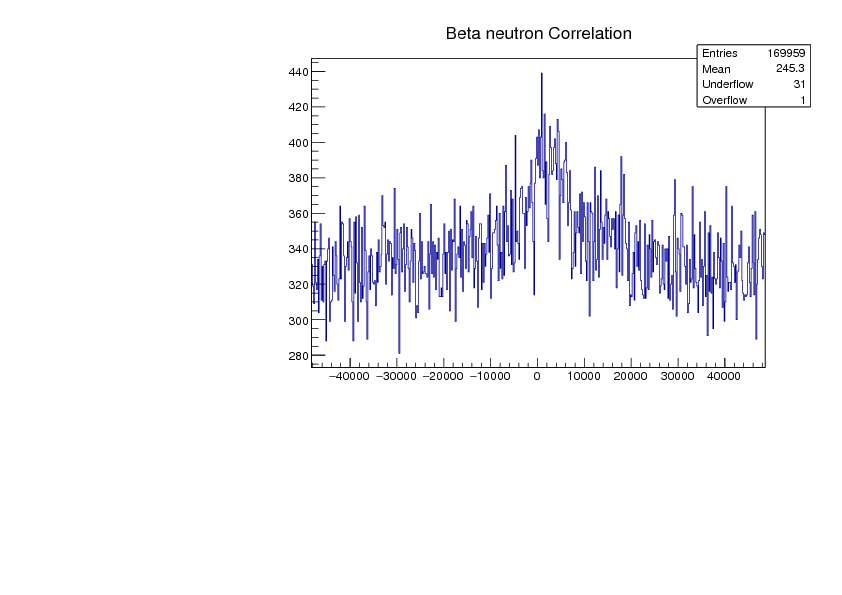
|
|
221
|
Thu Mar 30 01:46:30 2017 |
J.Agramunt | 40Mg Run 009 | Date: 30/03/2017
Start: 09:47
BRIKEN run: 009
AIDA Run: R16_126
BigRIPS run: run150
DLT: 170330_0948_Mg40_009.dlt
BRIKEN Rate: 4 cps
F11 Rate: 12 cps
Date: 30/03/2017
Stop: 11:51
BRIKEN run: 9
AIDA Run:R16_163
BigRIPS run: 151
Root file:170330_0947_1151_B009_Mg40.root
OBSERVATIONS:
Two BigRips files |
|
5
|
Tue Feb 24 09:34:54 2015 |
J. Agramunt, H. Baba, A. Estrade | [DAQ] DAQ correlation test |
We have performed a successful test of the integration of independent DAQ systems based on a correlation
scalar counted from a common clock signal. The principles of the integration method are described in the
following AIDA elog entry: https://elog.ph.ed.ac.uk/AIDA/29
The configuration of the setup we used in the RIKEN test is described by the attached figure:
DAQcorrelation_diagram.pdf. The chosen solution was to use a 25 MHz clock generated by the MACB modules of
AIDA, which was distributed to the other two systems by a SIS36/38xx module in the BRIKEN VME crate (a
slightly modified versio of the method proposed by PCS in AIDA Elog#29).
The correlation can be monitored online using the MIDAS DataXfer and DataSpy toolkits
(http://npg.dl.ac.uk/MIDAS/DataAcq/Data.html). Each system operates a DataRelay program that sends a data
stream consisting only of IDs and time-stamps to a common DataSink (this requires a DataRelay code that
does
some filtering of the raw data). The scheme is shown in the attached diagram (DAQsoftware.pdf).
The DataPeek_Merge and SyncCheck codes use C++11 for parallelization of tasks, which is a helpful feature
to
improve the efficiency of finding coincidences between the correlation pulses. Thus, the code will not
run
in PCs with any Linux version. For example, it requires version 7 of ScientificLinux, which installed in
the
PC being used for BRIKEN DAQ control that will stay at RIBF for the time being.
++ SYNCHRONIZATION RESULTS ++
The figure correlation_25Hz.png shows a correlation plot for the BRIKEN+RIBF+AIDA running with
correlations
done by a pulser at 25 Hz. A large fraction of the pulsers appear in the double-coincidence plots (top
row;
same plots, except the 'Partial' one is automatically cleared every ~10seconds).
The bottom plots show the pair-wise correlations between BRIKEN and RIBF or AIDA. BRIKEN was defined as
the
'master' in this test, but current version of the program is flexible to select any stream as the master
one.
The second figure (correlation_random.png) shows the same test, but using a non-periodic pulser to trigger
the correlation scalar. We observed the same level of synchronization (peaks look broader because of the
zoom level). |
| Attachment 1: DAQcorrelation_diagram.pdf
|
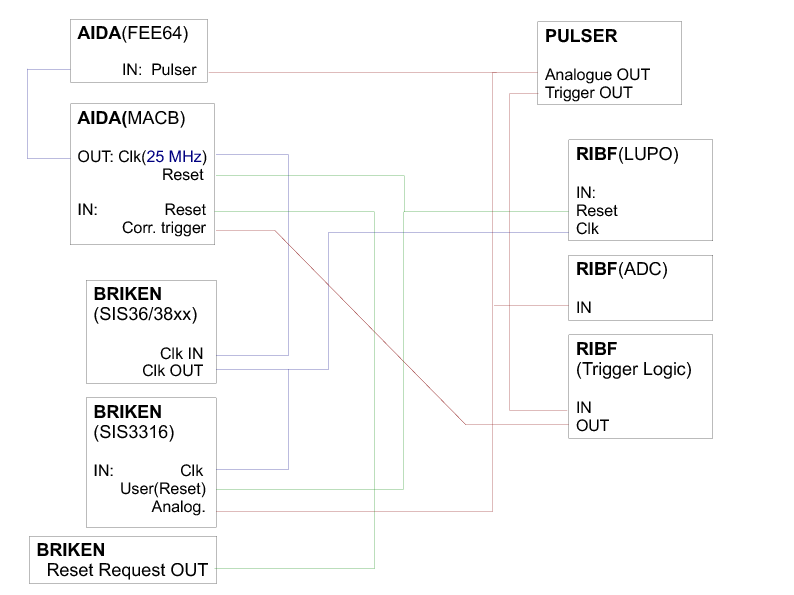
|
| Attachment 2: DAQsoftware.pdf
|
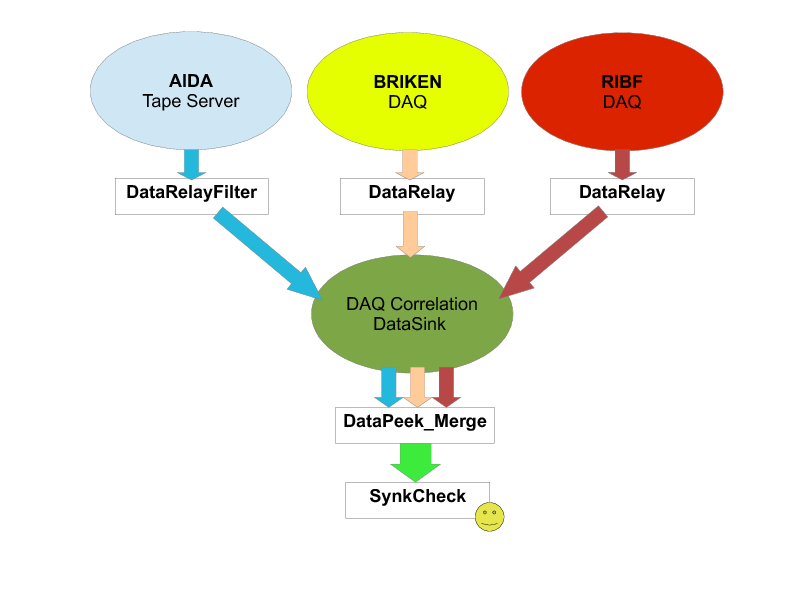
|
| Attachment 3: correlation_25Hz.png
|
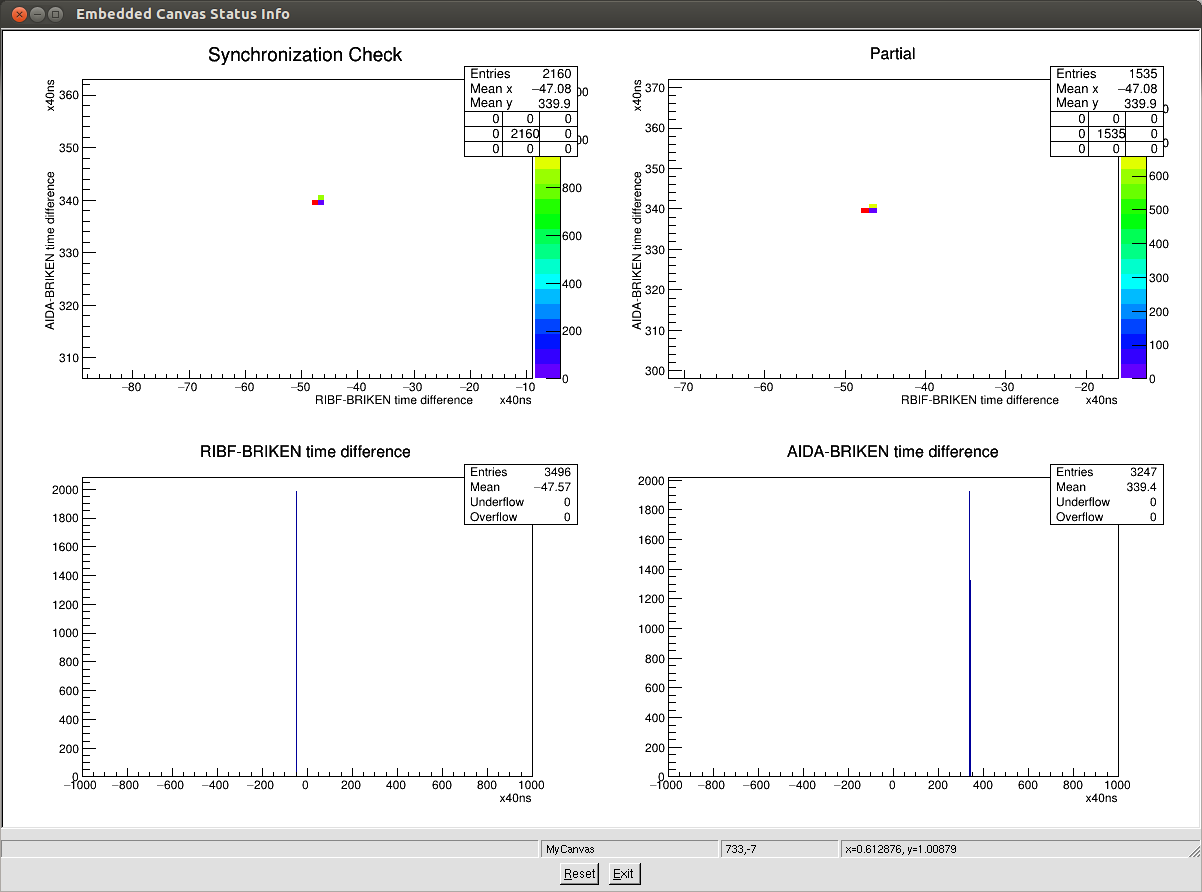
|
| Attachment 4: correlation_random.png
|
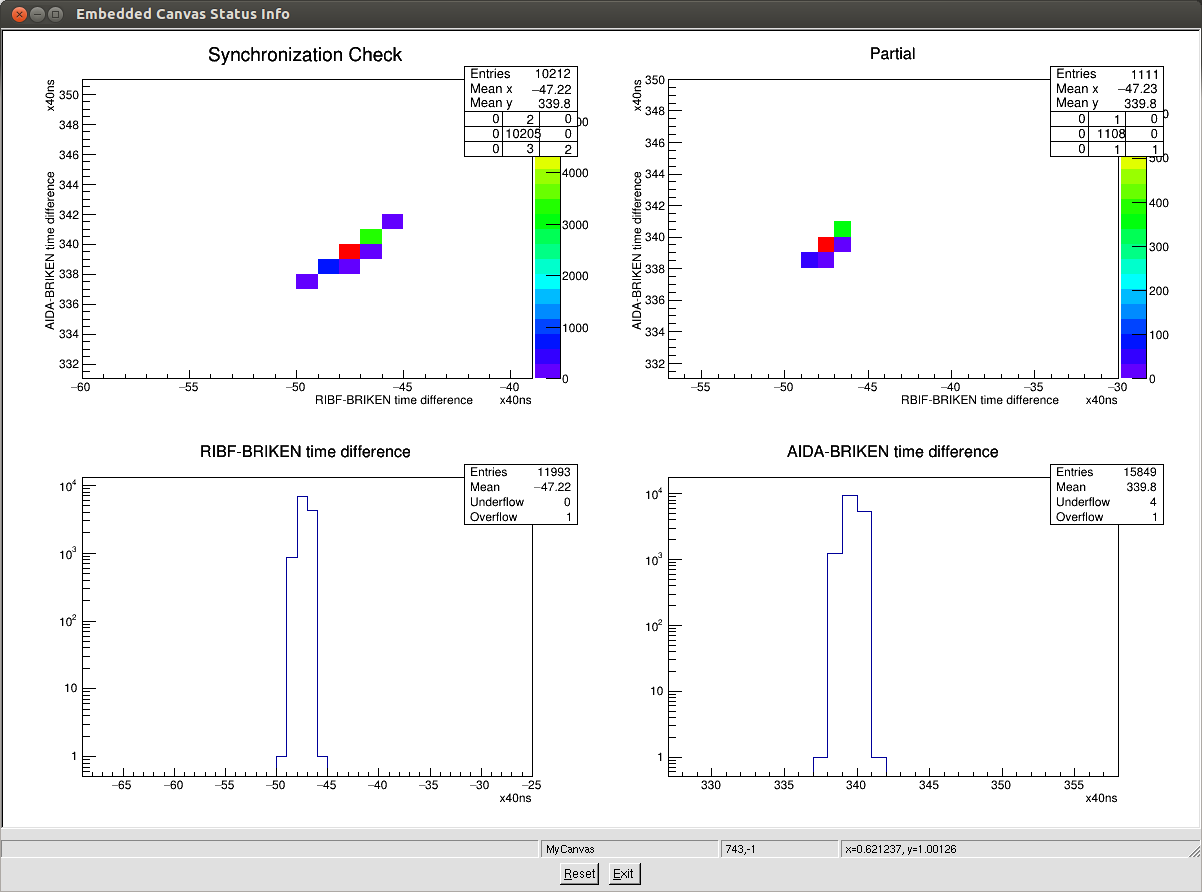
|
|
58
|
Wed Jul 20 17:21:59 2016 |
J. Agramunt, A. Tolosa | DACQ | DACQ configuration parameters
The last configuration file used was: 160718Conf_BrikenFull_cal5.xlsx
Most relevant configuration parameters:
3He tubes:
For all channels:
Input: InputRange: 2V, Impedance: 50Ohm
Tigger: Fast filter IntTime: 40, FlatTop: 20
V1A1C1-C16: (RIKEN: PA1,PA2)
Input: Offset: 50000, Polarity: + (POS)
Trigger: GateLength: 800, PreTrigger: 250, Threshold: 2000
Slow Filter: IntTime: 250, FlatTop: 50, Tau: 25000
V1A2C1-C8: (RIKEN: PA2)
Input: Offset: 50000, Polarity: + (POS)
Trigger: GateLength: 800, PreTrigger: 250, Threshold: 2000
Slow Filter: IntTime: 250, FlatTop: 50, Tau: 25000
V1A2C9-C16: (UPC: PA3)
Input: Offset: 50000, Polarity: + (POS)
Trigger: GateLength: 800, PreTrigger: 250, Threshold: 10000
Slow Filter: IntTime: 175, FlatTop: 50, Tau: 25000
V1A3C1-C16: (UPC: PA3,PA4)
Input: Offset: 50000, Polarity: + (POS)
Trigger: GateLength: 800, PreTrigger: 250, Threshold: 10000
Slow Filter: IntTime: 175, FlatTop: 50, Tau: 25000
V1A4C1-C4: (UPC: PA4)
Input: Offset: 50000, Polarity: + (POS)
Trigger: GateLength: 800, PreTrigger: 250, Threshold: 8000
Slow Filter: IntTime: 175, FlatTop: 50, Tau: 25000
V1A4C5-C16: (UPC: PA5)
Input: Offset: 15000, Polarity: - (NEG)
Trigger: GateLength: 1000, PreTrigger: 250, Threshold: 15000
Slow Filter: IntTime: 250, FlatTop: 100, Tau: 25000
V1A5C1-C16: (ORNL1: PA6)
Input: Offset: 15000, Polarity: - (NEG)
Trigger: GateLength: 1000, PreTrigger: 250, Threshold: 3000
Slow Filter: IntTime: 250, FlatTop: 100, Tau: 25000
V1A6C1-C16: (ORNL2: PA7)
Input: Offset: 15000, Polarity: - (NEG)
Trigger: GateLength: 1200, PreTrigger: 350, Threshold: 3000
Slow Filter: IntTime: 350, FlatTop: 100, Tau: 25000
V2A1C1-C8: (ORNL2: PA8) V2A2C1-C8: (ORNL2: PA8)
V2A3C1-C8: (ORNL2: PA9) V2A4C1-C8: (ORNL2: PA9)
V2A5C1-C8: (ORNL2: PA10) V2A6C1-C8: (ORNL2: PA10)
Input: Offset: 48000, Polarity: - (NEG)
Trigger: GateLength: 1000, PreTrigger: 100, Threshold: 200
Slow Filter: IntTime: 350, FlatTop: 100, Tau: 25000
CLOVERS:
Input: InputRange: 2V, Impedance: 50Ohm, Offset: 50000, Polarity: - (NEG)
Trigger: Fast filter IntTime: 20, FlatTop: 20, Threshold: 30
Trigger: GateLength: 750, PreTrigger: 75
Slow Filter: IntTime: 500, FlatTop: 50, Tau: 37000 |
| Attachment 1: 160718Conf_BrikenFull_cal5.xlsx
|
|
26
|
Wed May 6 11:41:24 2015 |
J. Agramunt, A. Estrade | First online combined analysis | Screen shot of the rudimentary on-line
analysis of the combined data:
BRIKEN-AIDA-BigRIPS
Top Left: dE (from MUSIC) vs. ToF (F11-F7)
Top Right: X-position (at F9) vs ToF
Middle Left: Amplitude spectrum of RIKEN tubes
Bottom Left: Energy spectrum from AIDA marked as beta-decays
Middle Right: Time correlations between betas (AIDA) and neutrons (BRIKEN)
Bottom Right: Time correlations between implants (AIDA) and neutrons (BRIKEN)
(the range of time correlated data [-1ms,+1ms]) |
| Attachment 1: Screenshot_from_2015-05-06_19_12_29.png
|

|
|
95
|
Mon Oct 31 23:56:37 2016 |
J. Agramunt | First AIDA BRIKEN correlation plot | From the 252Cf data. |
| Attachment 1: FirstAIDA_BRIKENPlot.pdf
|

|
|
207
|
Wed Mar 29 03:02:02 2017 |
J. Agramunt | Synchronization test procedure (update) | To Launch the processes:
Open 4 terminals:
Terminal 1 (DataSink) type:
>ssh aida@d05
>cd /home/aida/DataPackage/DataSink/Linux64
>DataSink -i 3
Terminal 2 (SynCheck) type:
>ssh aida@d05
>cd /home/aida/SyncCheck
>./SynCheck
Terminal 3 (BigRIPS Data Relay) type:
>ssh aida@d05
>cd /home/aida/ribfts/ribftssender
>./ribftssender_mar17ca debug
(specific for current 40Ca parasitic run because we are not sending
a pulse signal to BigRIPS as trigger but receiving triggers from
BigRIPS to create the pulses)
Terminal 4 (AIDA Data Relay) type:
>npg@aidas1
>DataRelayFilter -n 10.32.0.12 -p 10307 -I 2
"-I 2" selects ID 2 as the one for the AIDA data stream,
which must correspond to the one expected by the DataSink in the d05 PC.
The programming transmitting the data from AIDA to the DataSink includes an
intermediate filtering step. This selects only correlation scalers from one
module (and possibly ADC values from one channel in that module).
Gasific MainWindow (Briken Data Relay):
In the DAQ Control tab: Click "Start Sync Monitoring" button.
In the pop up window set server ip and port (ip:10.32.0.12, port:10305)
By default this perform a check on the differences RIBF-BRIKEN and AIDA-BRIKEN.
In case that BRIKEN is not running, the option "SynCheck -M 1" check the differences
AIDA-RIBF and BRIKEN-RIBF, while "SynCheck -M 2" checks RIBF-AIDA and BRIKEN-AIDA
To synchronize:
In the Gasific MainWindow, DAQ Control tab: Click "Send Sync Pulse" button |
|
208
|
Wed Mar 29 07:34:16 2017 |
J. Agramunt | BrikenTools repository installed at d05 | The last version of Briken tools repository has ben installed at d05, this repository includes the Merger and the BrikenOffline codes, as well as a CommonTools folder to share scripts and code.
For update versions, just type in the desired directory "svn update". |
|
219
|
Wed Mar 29 22:53:58 2017 |
J. Agramunt | 40Mg Run007 |
Date: 30/03/2017
Start: 07:18
BRIKEN run: 007
AIDA Run: R16_81
BigRIPS run: 148
DLT: 170330_0718_Mg40_007.dlt
BRIKEN Rate: 3cps
F11 Rate: 13
Date: 30/03/2017
Stop: 170330_0718_840_B007_Mg40.root
BRIKEN run:007
AIDA Run:R107
BigRIPS run:148
Root file: 170330_0718_840_B007_Mg40.root
OBSERVATIONS:
Sync ok |
|
220
|
Thu Mar 30 00:47:04 2017 |
J. Agramunt | 40Mg Run 008 | Date: 30/03/2017
Start: 08:41
BRIKEN run: 008
AIDA Run: R16_107
BigRIPS run: 149
DLT: 170330_0718_Mg40_008.dlt
BRIKEN Rate: 3.5 cps
F11 Rate: 12
Date: 30/03/2017
Stop: 09:46
BRIKEN run: 008
AIDA Run: R16_126
BigRIPS run: 149
Root file:170330_0840_0946_B008_Mg40.root
OBSERVATIONS: |
|
222
|
Thu Mar 30 03:55:42 2017 |
J. Agramunt | 40Mg Run 10 | Date: 30/03/2017
Start: 11:52
BRIKEN run: 010
AIDA Run: R16_163
BigRIPS run: run152
DLT: 170330_1152_Mg40_010.dlt
BRIKEN Rate: 4 cps
F11 Rate: 12 cps
Date: 30/03/2017
Stop: 12:47
BRIKEN run: 010
AIDA Run: R16_178
BigRIPS run: 152
Root file:170330_0947_1247_B010_Mg40.root
OBSERVATIONS: |
|
308
|
Fri May 26 09:07:46 2017 |
J. Agramunt | Synchronization Monitoring | We started the synchronization monitoring programs to check that
it is OK as can be seen in the figure below
We are using the same scheme used during Ahn parasitic run,
namely the synchronization check signal is the BigRIPS trigger
signal send by them to us (AIDA, BRIKEN).
The monitorization procedure is different from the one used
in 2016. The description to lauch the processes is described
here below and in the attached PDF.
***********
To Launch the processes:
Open 4 terminals:
Terminal 1 (DataSink) type:
>ssh aida@d05
>cd /home/aida/DataPackage/DataSink/Linux64
>DataSink -i 3
Terminal 2 (SynCheck) type:
>ssh aida@d05
>cd /home/aida/SyncCheck
>./SynCheck
Terminal 3 (BigRIPS Data Relay) type:
>ssh aida@d05
>cd /home/aida/ribfts/ribftssender
>./ribftssender_mar17ca debug
(specific for current 40Ca parasitic run because we are not sending
a pulse signal to BigRIPS as trigger but receiving triggers from
BigRIPS to create the pulses)
Terminal 4 (AIDA Data Relay) type:
>npg@aidas1
>DataRelayFilter -n 10.32.0.12 -p 10307 -I 2
"-I 2" selects ID 2 as the one for the AIDA data stream,
which must correspond to the one expected by the DataSink in the d05 PC.
The programming transmitting the data from AIDA to the DataSink includes an
intermediate filtering step. This selects only correlation scalers from one
module (and possibly ADC values from one channel in that module).
Gasific MainWindow (Briken Data Relay):
In the DAQ Control tab: Click "Start Sync Monitoring" button.
In the pop up window set server ip and port (ip:10.32.0.12, port:10305)
By default this perform a check on the differences RIBF-BRIKEN and AIDA-BRIKEN.
In case that BRIKEN is not running, the option "SynCheck -M 1" check the differences
AIDA-RIBF and BRIKEN-RIBF, while "SynCheck -M 2" checks RIBF-AIDA and BRIKEN-AIDA
To synchronize:
In the Gasific MainWindow, DAQ Control tab: Click "Send Sync Pulse" button |
| Attachment 1: synchroCheck.png
|
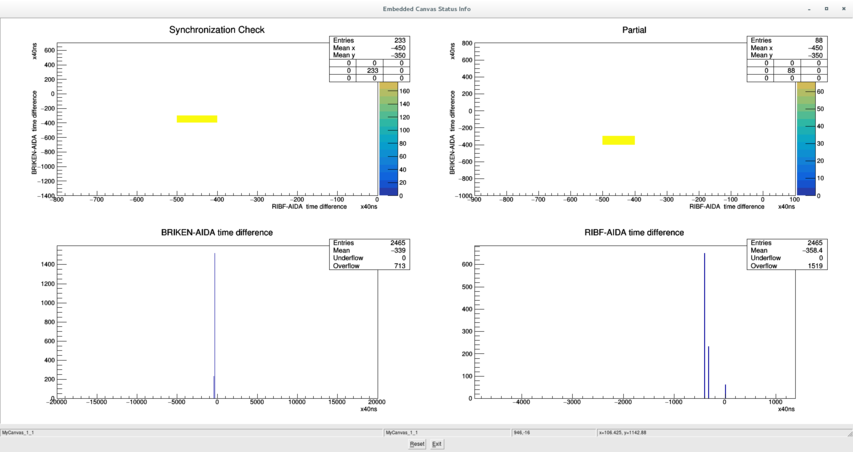
|
| Attachment 2: SynchronizationMonitoring.pdf
|

|
|